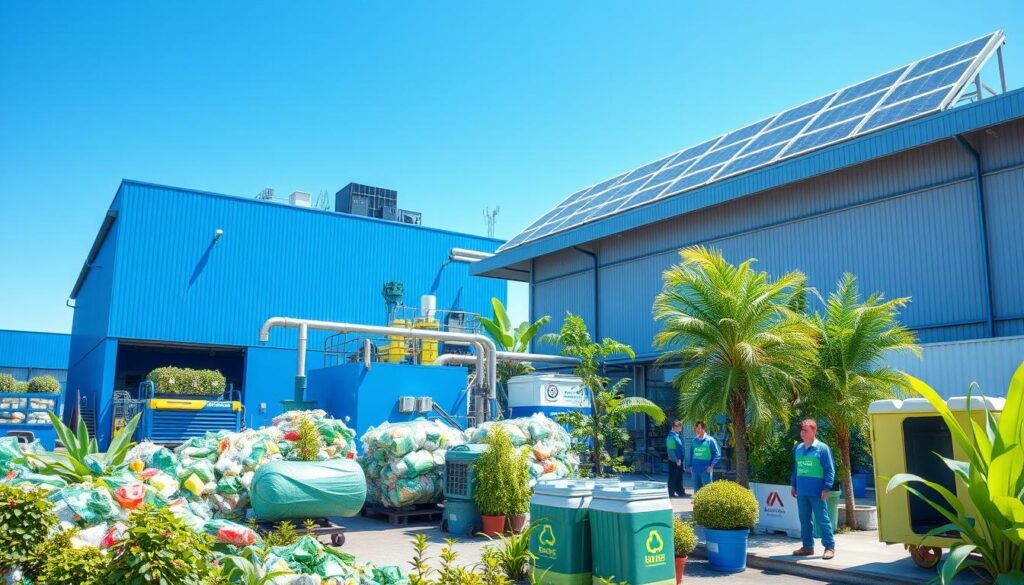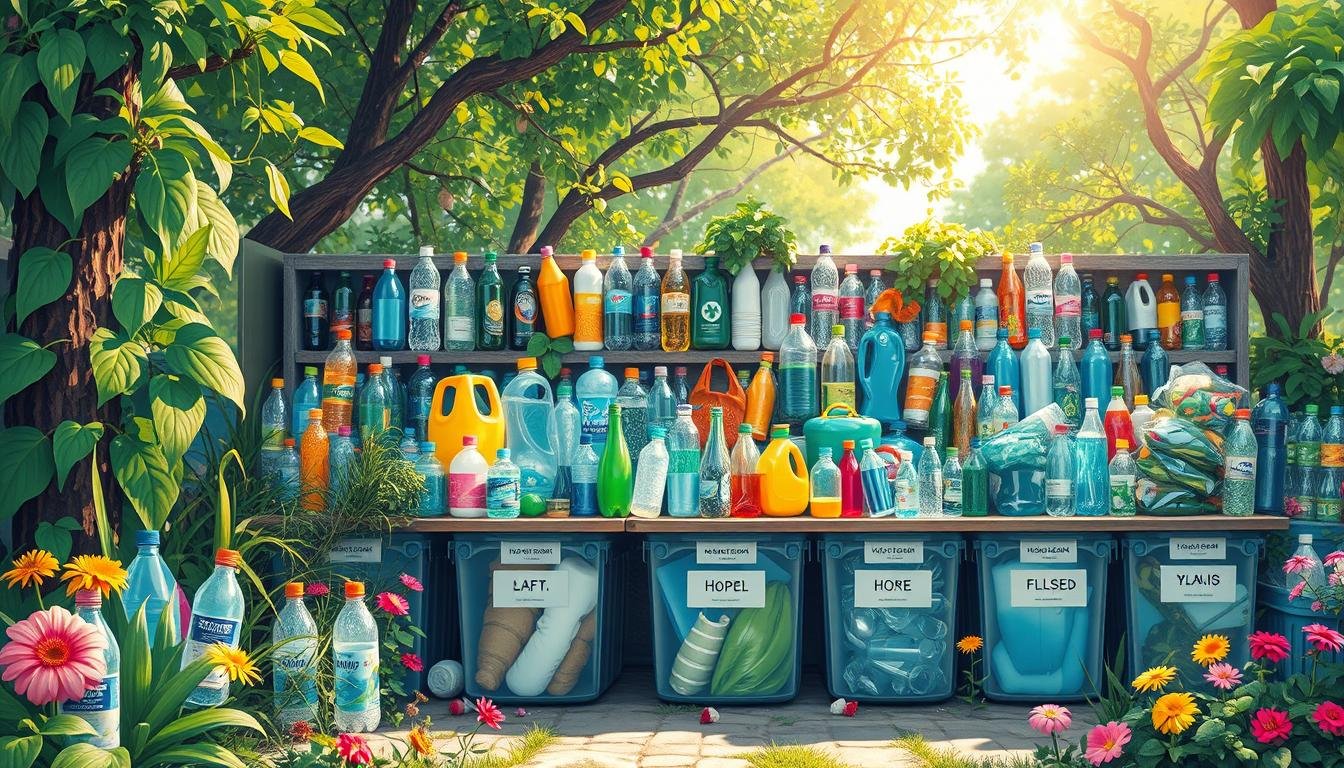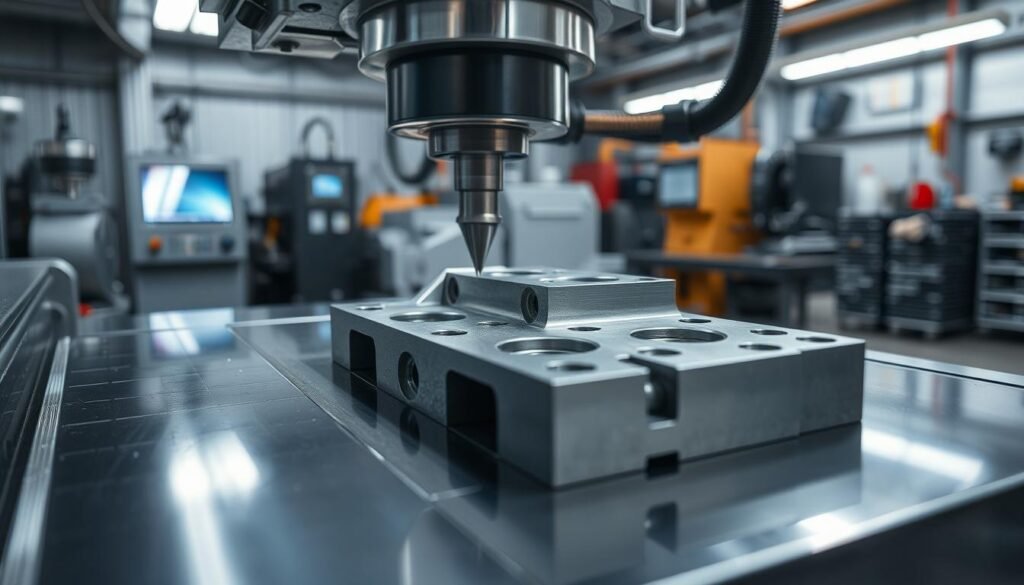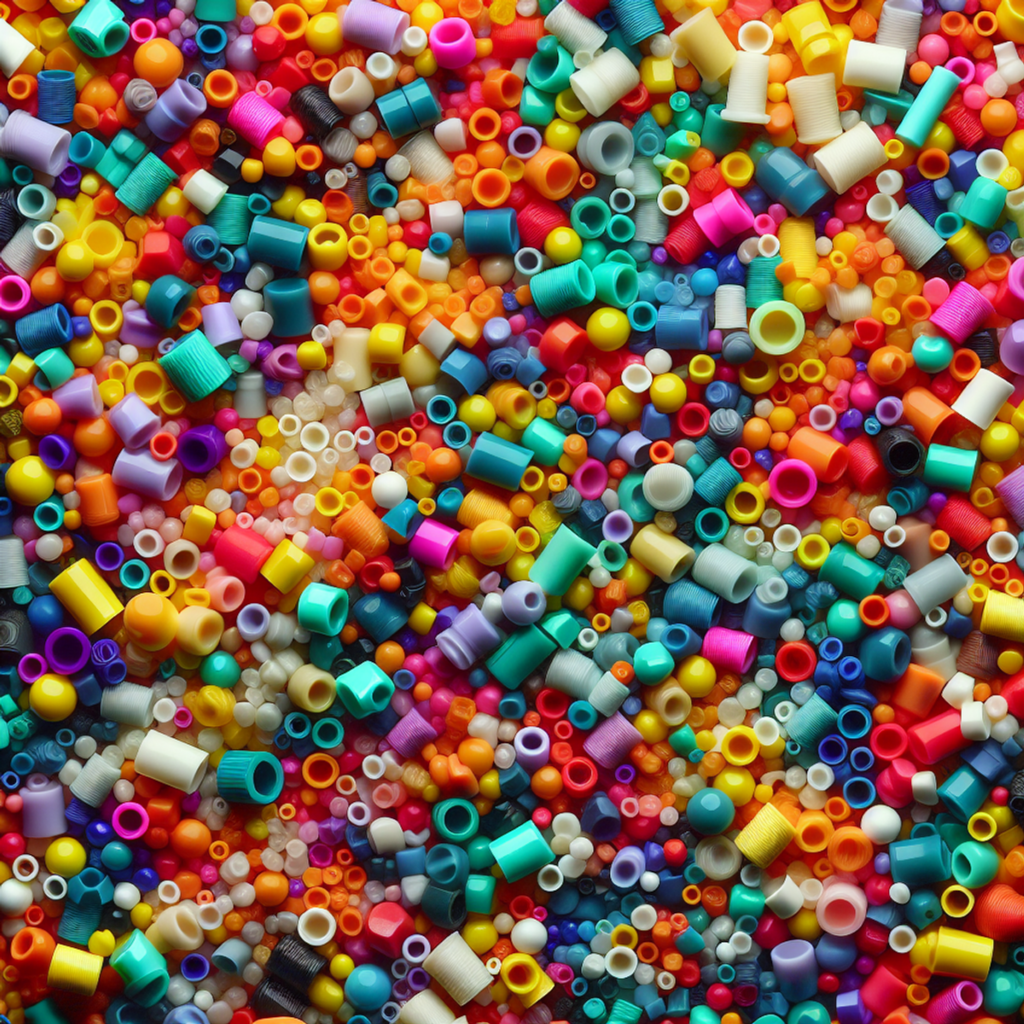Less than 10% of the seven billion tonnes of plastic waste made globally has been recycled, says the UN Environment Programme. This shows we really need to tackle the plastic crisis and live more sustainably. Plastic is everywhere in our lives but harms our planet and natural resources badly.
Recycling is key to living sustainably. It helps cut down waste, saves natural resources, and lessens environmental damage from bad plastic disposal. This guide will cover why plastic recycling matters, its benefits, and how to recycle well. It aims to help make our future cleaner and greener.
Key Takeaways
- Plastic recycling is essential for sustainable living, reducing waste and conserving natural resources.
- Less than 10% of global plastic waste has been recycled, highlighting the urgent need for improved recycling practices.
- Recycling symbols on plastic products provide guidance on the proper recycling process for different plastic types.
- Improper disposal of plastics can lead to damaged recycling equipment and contaminated recyclables.
- Understanding the unique properties of common plastic types, such as PET, HDPE, and PVC, is crucial for effective recycling.
The Importance of Plastic Recycling
Plastic waste is a big problem, filling up landfills and oceans. But recycling plastic is key. Recyclable plastics can be turned into new things, saving resources and energy.
Reducing Plastic Waste in Landfills and Oceans
Plastics take ages to break down. They harm wildlife and the environment in landfills and oceans. Recycling plastic helps a lot. According to the Environmental Protection Agency, plastics made up over 12% of waste in the U.S. in 2018, up from less than 1% in 1960.
Conserving Natural Resources and Energy
Recycling plastic saves resources and energy. A study by the Pacific Institute of California found making a pint of bottled water uses 2,000 times more energy than tap water. Recycling plastic means we use less oil and other resources.
“Recycling one ton of plastic saves 7.4 cubic yards of landfill space.”
But, plastic recycling rates in the U.S. are low. Only 4.4% of plastics were recycled in 2018, showing a big need for more recycling. We need more people to recycle to make our future better.
Blue Standard Inc.: Leading the Way in Plastic Recycling
Blue Standard Inc. is a beacon of hope in the plastic crisis. They lead in recycling technology for plastics, ocean-bound plastics, wood, and textiles. Their goal is to cut down plastic waste and find sustainable ways.
Blue Standard Inc. has put a lot into research and development. They’ve created technology to turn plastic waste into quality recycled plastic. This helps reduce the need for new plastic and keeps oceans and landfills clean.
| Sustainable Material | Environmental Impact |
|---|---|
| Circular Textiles | Reduces CO2 emissions by up to 97%, wastewater by 99%, and non-renewable resource use by 96% |
| Vernovo (Biodegradable Alternative) | Made from natural and renewable resources, providing a compostable solution |
Blue Standard Inc. doesn’t just focus on plastic. They also work on sustainable wood and textiles. These come from responsibly managed forests and are made in green ways. They aim to lessen our plastic use with eco-friendly options.
“Transitioning to circular economies decreases emissions associated with new plastic production, minimizes waste accumulation, conserves resources, and fosters innovation and market transformation.”
The company is all about sustainability. They use closed-loop manufacturing to recycle materials and save resources. By using green energy and improving their processes, they’re leading the way in eco-friendly practices.
Blue Standard Inc. is a key player in solving the plastic crisis. Their innovative work shows how dedication to sustainability can make a big difference. They’re helping create a future where plastic waste is a valuable resource, not a problem.

Plastic Recycling
Recycling plastic waste is a complex task. It needs advanced technology and expertise. Blue Standard Inc. leads in this field, sorting, cleaning, and preparing plastics for reuse. This careful process makes sure the recycled plastic is top quality.
The first step is sorting. Plastics have numbers from 1 to 7, showing their type. Blue Standard uses top-notch sorting tools to separate plastics by type. This ensures each plastic is processed right.
Then, the sorted plastics go through a detailed cleaning process. This is key because any food or dirt can mess up recycling. Blue Standard’s cleaning methods make sure plastics are clean and ready for the next step.
The last step is preparing the plastics for new use. This means shredding, melting, and shaping them into new materials. Thanks to Blue Standard’s special tools and skills, they turn recycled plastics into quality raw materials. These can be used in many things, like packaging and building materials.
Blue Standard Inc. turns waste into valuable resources through this detailed recycling process. Their focus on innovation and caring for the environment makes them a top name in the field.
“Our goal is to make recycling not just a necessity, but a natural part of everyday life. By providing a reliable and efficient plastic recycling solution, we’re able to turn waste into new opportunities for our community and the planet.”
– Blue Standard Inc. CEO
The Benefits of Recycling Plastic
Recycling plastic has many good points for our planet and wallets. It helps us live more sustainably. By recycling, we can cut down on waste, save natural resources, and help local businesses.
Environmental Benefits
Recycling plastic is key to lessening plastic waste in landfills and oceans. Plastic can take 100 to 1,000 years to break down. Most plastic isn’t recycled, causing big pollution problems. Recycling plastic stops this waste from harming our environment and sea life.
It also saves natural resources. Recycling plastic means we don’t need to use as much oil to make new plastic. Plus, recycling uses less energy than making new plastic. This cuts down on harmful gases, making it better for our planet.
Recycling one ton of plastic saves enough energy to power a home for seven months. This shows how big the environmental wins are from recycling.
Economic Benefits
Plastic recycling is good for the planet and helps local jobs. The recycling industry creates jobs in collecting, sorting, and processing recyclables. Recycling goals, like the UK’s 70% target by 2025, can lead to thousands of new jobs.
The sale of recycled plastic also brings in money. This helps the economy stay strong. Blue Standard Inc. works with businesses and communities to increase plastic recycling. They help make the economy circular, where materials are reused instead of thrown away.
“Recycling plastic helps reduce the amount of harmful greenhouse gases entering the atmosphere and conserves natural resources, making it a crucial step towards a more sustainable future.”
How to Recycle Plastic Effectively
Recycling plastic helps save our planet. It’s key to know how to do it right. Your local rules are important to follow.
First, learn what plastic you can recycle. There are seven main types. But, not all can be recycled in every place. Mostly, only numbers one and two are accepted.
Make sure your plastic is clean and dry. Flatten it to save space. Don’t mix it with things that can’t be recycled. This keeps the recycling process working well.
Rules for recycling plastic vary by area. Check with your local government for specific rules. Some places have special programs for certain plastics.
By following these tips, you help recycle plastic better. This reduces waste and protects our environment.
| Plastic Type | Recyclability |
|---|---|
| PET (Polyethylene Terephthalate) | Widely recycled |
| HDPE (High-Density Polyethylene) | Widely recycled |
| PVC (Polyvinyl Chloride) | Rarely recycled due to toxicity |
| LDPE (Low-Density Polyethylene) | Widely recycled |
| PP (Polypropylene) | Less frequently recycled due to processing challenges |
| PS (Polystyrene) | Rarely recycled due to energy inefficiency |
| Other | Generally not included in the recycling process |
Knowing about plastic types helps you recycle better. It’s important for a greener future. Let’s all do our part to recycle and reduce waste.
Sustainable Living Through Plastic Recycling
Plastic recycling is key to living sustainably. It helps us reduce, reuse, and recycle plastic. This way, we can greatly help the environment.
Reducing single-use plastics, reusing items, and recycling plastic waste are important. They help us live more sustainably.
Recycling plastic is good for the environment. It keeps plastic out of landfills and oceans. This saves natural resources and cuts down energy use.
In 2005, 21.8% of plastics packaging was recycled. In the UK, 42% of EPS packaging made in 2006 was recycled.
Supporting companies like Blue Standard Inc. helps our planet. They work on new ways to recycle plastic. This makes our environment cleaner for the future.
Using 100 kg of plastics can replace 200 – 300 kg of other materials. This shows how recycling plastic can lessen our environmental impact.
| Statistic | Value |
|---|---|
| Oil production used for plastics | 4% |
| Plastics packaging recycled in 2005 | 21.8% |
| EPS packaging recycled in the UK in 2006 | 42% |
| Plastics replaced by 100 kg in cars | 200 – 300 kg |
Living sustainably with plastic recycling is good for us and the planet. By using less single-use plastics and recycling, we help make the future cleaner.

Plastic recycling is a big step towards a greener world. By recycling and supporting new recycling ideas, we can all help protect our planet for the future.
Other Materials for Recycling
Blue Standard Inc. is all about recycling more than just plastic. They focus on wood and textile recycling too. This helps build a circular economy where we use resources better.
Recycling wood saves our forests and fights deforestation. Blue Standard Inc. helps by using wood again. This makes our planet greener.
Textile recycling is also key for the company. They tackle the big problem of textile waste. By recycling clothes, they help the environment and support green fashion.
Blue Standard Inc. leads in recycling wood, textiles, and more. They aim for a circular economy. This way, we don’t waste resources but use them again.
| Recyclable Material | Recycling Benefits |
|---|---|
| Wood | Conserves natural resources, reduces deforestation |
| Textiles | Diverts textile waste from landfills, promotes sustainable fashion |
Blue Standard Inc. is making big changes with their recycling efforts. They focus on wood and textiles. This helps us live more sustainably and saves our planet.
Conclusion
Plastic recycling is key to a cleaner future. It helps reduce waste and saves natural resources. By recycling, we all play a big role in protecting our planet.
Companies like Blue Standard Inc. are finding new ways to deal with plastic waste. Their work shows us how we can help make the future greener. By supporting them, we can all help create a sustainable future.
Even though plastics are everywhere, we’re starting to see the need to recycle more. New recycling methods and policies are helping. These steps show us we can make a big change for the better.
By recycling more, we can make our world a greener place. We can do this by recycling at home and supporting big recycling efforts. Together, we can make a big difference.
We need to keep talking about the importance of recycling. We must also support new ideas and policies to fight plastic waste. If we work together, we can make our planet a cleaner, healthier place for all.
FAQ
What is the importance of plastic recycling?
Plastic recycling cuts down on waste in landfills and oceans. It saves natural resources and lowers greenhouse gas emissions. This helps create a greener future.
What is Blue Standard Inc. and how are they innovating in plastic recycling?
Blue Standard Inc. leads in making new tech for recycling plastics, ocean plastics, wood, and textiles. They aim to lessen plastic waste and find easy ways to recycle.
How does the plastic recycling process work?
Recycling plastic is a detailed process. It includes sorting, cleaning, and getting plastics ready for new use. Blue Standard Inc. uses advanced tech to make sure the recycled plastic is top-notch.
What are the benefits of recycling plastic?
Recycling plastic is good for the planet and the economy. It cuts down on waste, saves resources, and lowers emissions. It also helps local jobs and brings in money from recycled materials.
What are the key steps to effectively recycle plastic?
To recycle plastic well, know what can be recycled in your area. Clean, sort, and flatten the plastic. Don’t mix it with things that can’t be recycled.
What other materials does Blue Standard Inc. support recycling?
Blue Standard Inc. also recycles wood and textiles. This helps build a world where waste is less and resources are reused.
Source Links
- https://www.keramida.com/blog/easy-guide-to-plastic-recycling
- https://ecocycle.org/eco-living/recycling-101/recycling-plastics/
- https://www.treehugger.com/benefits-of-plastic-recycling-1204142
- https://www.nature.com/articles/s44296-024-00024-w
- https://www.recycling.com/why-is-plastic-recycling-important/
- https://bluestandardinc.com/blogs/news/plastic-pollution-and-its-role-in-global-emissions-how-we-can-close-the-loop-with-innovative-solutions
- https://bluestandardinc.com/blogs/news/is-recycling-plastic-enough-examining-the-environmental-impacts-of-plastic-production
- https://www.standardtextile.com/news/standard-textile-eliminates-poly-bags-from-us-made-products/
- https://recyclingworksma.com/how-to/materials-guidance/recycled-plastics/
- https://repurpose.global/blog/post/why-is-most-plastic-not-recycled
- https://www.allcountyrecycling.com/blog/2019/the-benefits-of-recycling-plastic.html
- https://togetherband.org/blogs/news/plastic-recycling-advantages?srsltid=AfmBOoqbDE4hrHV3lvu2q3S4ZnMapevvZbQ-LJMMfya_5SthZUnyAq8F
- https://www.ubqmaterials.com/blog-post/plastic-recycling-technology-what-are-the-environmental-benefits/
- https://www.rts.com/blog/the-complete-plastics-recycling-process-rts/
- https://sensoneo.com/waste-library/how-to-properly-recycle-plastic/
- https://www.bpf.co.uk/Sustainability/Plastics_and_Sustainability.aspx
- https://libraryguides.binghamton.edu/c.php?g=1106235&p=9427940
- https://www.slrecyclingltd.co.uk/what-plastics-can-and-cannot-be-recycled/
- https://www.hprc.org/resources/common-recyclable-healthcare-plastics/
- https://www.consumerreports.org/recycling/smarter-which-plastics-are-actually-recyclable-a4433898936/?srsltid=AfmBOooFwKXKQJJe6wxHy29ymIAqRh5OzTn12x1IHc1e4cU8vA6MZxaC
- https://www.rstreet.org/commentary/to-reduce-plastic-pollution-recycling-improvements-are-key/
- https://www.ncbi.nlm.nih.gov/pmc/articles/PMC2873020/
- https://ecologycenter.org/blog/what-is-greenwashing-in-plastics-recycling/






